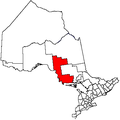This article relies largely or entirely on a single source .(March 2020) |

Aweres is a local services board in the Canadian province of Ontario. Located in the Algoma District, it encompasses and provides services to most of the geographic township of Aweres, including the communities of Island Lake and Heyden. [1]
The area northwest of Heyden is administered by the separate local services board of Peace Tree. [1]
